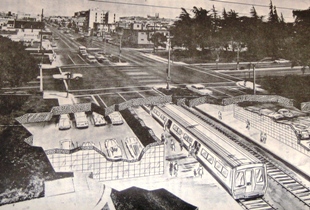As I happened to mention in the previous post, Geary was the birthplace of Muni. The old A, B, C streetcar lines ran down Geary. These lines were ripped out, however, in part because the original BART plan had a line going under Geary:

Artist's conception of a proposed BART station below Geary and Park Presidio Blvds
The idea was that a streetcar line above ground provided redundant service to the rapid, heavy rail line below. In later years the entire Geary corridor was further redesigned to move motor traffic more quickly. The end result in 2008 2009 is that one of San Francisco's most dense neighborhoods, the Richmond District, is drastically under served by transit; most riders funnel onto the 38, which is the busiest single line in Muni's system. The entire Geary corridor is the second most heavily-traveled, with 56,473 daily boardings along its four bus lines.
There are plans in the works (though currently years away from implimentation) to remake Geary with a bus rapid transit (BRT) line down the middle. One of the alternatives discussed in the official plans is to build a BRT right of way that could be retrofitted in a few years to run light rail (a reborn B-line?) from downtown to Ocean Beach. But why wait? Are we suggesting that Geary, with 30,000 more daily riders that pre-T Third St or 5,000 more daily riders than the N-Judah (Muni's busiest extant rail line), is less deserving of full-blown light rail than those lines?
Geary needs light rail now! More than that, it needs comprehensive transit options, with convenient local service and rapid cross-town access. Geary needs what Market St. has right now: A streetcar on the surface (preferably in its own ROW) to move neighbors to shops and provide convenient access to local amenities, and a subway line below to get commuters across town quickly.
Arguments that demand for transit need to be proven before a system so robust is built are flawed to begin with, but in the case of Geary, the demand for ridership is already proven. Induced demand has been proven in road projects, and a similar results can happen along "overbuilt" transit lines. To give San Francisco a web of transit arteries would be to build a system that is capable of accomodating growth for the future.
There are plans in the works (though currently years away from implimentation) to remake Geary with a bus rapid transit (BRT) line down the middle. One of the alternatives discussed in the official plans is to build a BRT right of way that could be retrofitted in a few years to run light rail (a reborn B-line?) from downtown to Ocean Beach. But why wait? Are we suggesting that Geary, with 30,000 more daily riders that pre-T Third St or 5,000 more daily riders than the N-Judah (Muni's busiest extant rail line), is less deserving of full-blown light rail than those lines?
Geary needs light rail now! More than that, it needs comprehensive transit options, with convenient local service and rapid cross-town access. Geary needs what Market St. has right now: A streetcar on the surface (preferably in its own ROW) to move neighbors to shops and provide convenient access to local amenities, and a subway line below to get commuters across town quickly.
Arguments that demand for transit need to be proven before a system so robust is built are flawed to begin with, but in the case of Geary, the demand for ridership is already proven. Induced demand has been proven in road projects, and a similar results can happen along "overbuilt" transit lines. To give San Francisco a web of transit arteries would be to build a system that is capable of accomodating growth for the future.





No comments:
Post a Comment